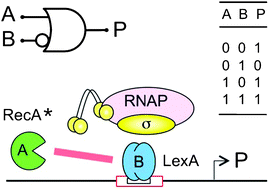Implementing an OR–NOT (ORN) logic gate with components of the SOS regulatory network of Escherichia coli
Abstract
Whether biological or electronic, man-engineered computation is based on logic circuits assembled with binary gates that are interconnected to perform Boolean operations. We report here the rewiring of the SOS system of Escherichia in a fashion that makes the output of both the recA and lexA promoters to faithfully follow the pattern of a binary composite OR–NOT gate (ORN) in which the inputs are DNA damage (e.g. nalidixic acid addition) and IPTG as an exogenous signal. Unlike other non-natural gates whose implementation requires changes in genes and promoters of the genome of the host cells, this ORN was brought about by the sole addition of wild-type bacteria with a plasmid encoding a module for LacIq-dependent expression of lexA. Specifically, we demonstrate that the interplay between native, chromosomally-encoded components of the SOS system and the extra parts engineered in such a plasmid made the desired performance to happen without any modification of the core DNA-damage response network. It is thus possible to artificially interface autonomous cell networks with a predetermined logic by means of Boolean gates built with regulatory elements already functioning in the recipient organism.


 Please wait while we load your content...
Please wait while we load your content...